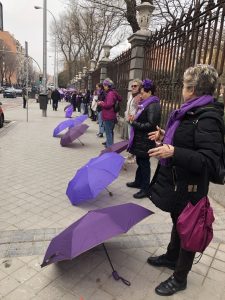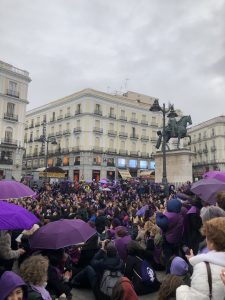Micaela Pattison explores the history of the colour purple within feminist protest, particularly as it pertains to the Spanish experience.
At nightfall on 8 March 2018, a reported ‘purple tide’ in Spanish politics took physical form. Millions marched through the streets of major cities wearing t-shirts, face-paint, and neckerchiefs in every shade of purple. In Madrid, marchers passed the Plaza de Cibeles, its iconic fountain and the stately town hall building glowing in Pantone’s colour of 2018: ultraviolet. Protestors brandished flags, banners and homemade signs with slogans in vibrant purple lettering: ‘If we strike, the world stops!’

The demonstrations marked the close of a 24-hour feminist strike (huelga feminista) called by a state-wide ‘8M strike committee’ that formed in 2017 to answer calls for an International Women’s Strike (Paro Internacional de Mujeres). On International Women’s Day—or ‘8M’ as it’s now commonly known in Spain—five million women and gender diverse people took the day off from employment, care work, education and consumerism.
When the strike ended, banners came down and purple paint was scrubbed from city walls and feminist faces. But something had changed. Many see 8 March 2018 as the turning point that brought feminist concepts and symbols from the fringes to the centre of politics and everyday life. The strike had the support of professional women’s associations, trade unions, and the proudly feminist left-wing mayors of Madrid and Barcelona. It brought unity to a fragmented and geographically dispersed feminist movement and rallied tens of thousands of new activists to the cause.
The 8M movement created a powerful activist base primed to snap to action and unfold purple banners to take to the streets to protest gender-based violence and patriarchal authority in law and institutions. Recent legislation to secure reproductive justice, gender self-identification and affirmative consent reflected the success of sustained protest action and grassroots feminist campaigns in the five years since the first 24 hour strike.

Commentators popularised a metaphor from young adult novel Carlota’s Violet Diary (2001) by attributing the strike’s success to the fact that people in Spain have ‘put on purple glasses’ (ponerse las gafas violetas). These purple-tinted lenses give the wearer a clear view of structural connections between different forms of gender inequality; and of global and historical struggles to dismantle them.
While purple was first employed by activist collectives as a symbol of autonomous feminist organising during Spain’s post-Franco period of democratic transition (1975-1978), it became universally recognised as ‘el color del feminismo’— the ‘feminist colour’ or ‘colour of feminism’— in the digital age. Popular discussion of the ubiquity of purple in feminist protest underlines the visual attractiveness and marketability of a colour recognised around the world as a symbol of feminist struggle.
Reports place the decidedly dull suggestion that purple represents gender equality by mixing blue and pink alongside more bracing accounts of its incorporation into the suffragette tricolour proudly waved by members of the Women’s Social and Political Union (WSPU) from 1908, and a popular legend that suggests working-class feminists chose the colour as a poignant reminder of dye-stained smoke that engulfed the Manhattan skyline as the calamitous Triangle Shirtwaist Factory fire raged in 1911.
In the absence of a common understanding of the origins and meaning of the ‘feminist colour’, purple is largely untethered from specific currents or trajectories of feminist struggle. It can be mapped onto what historian Nerea Aresti recently described as ‘the many paths to feminism in modern Spain’.

Purple has meant different things to the feminists who have used it. Emmeline Pethick Lawrence explained that purple was chosen for WSPU iconography to signify the ‘royal blood that flows in the veins of every suffragette, the instinct of freedom and dignity’. In European history, purple has been linked to royalty due its use for garments worn by Roman and Byzantine emperors. For speakers of English, the link to royalty is reflected in our language. The word ‘purple’ derives from purpura, or Tyrian purple, the shade of a highly valued dye extracted from a mollusc found on the shores of Tyre in ancient Phoenicia and used for royal garments.
In Spanish, on the other hand, purple is translated as violeta (violet), lila (lilac) or morado (derived from the word for blackberry—mora). All three are offhandedly referred to as ‘the feminist colour’. Morado technically refers to a deeper and darker shade of purple. It is used in colloquial Spanish as a synonym for bruise. Morado is the Catholic liturgical colour used for Advent, Lent and Requiem Masses. It represents mourning and the pain and suffering of crucifixion. These cultural uses likely inform the colour’s meaning and power as a symbol of struggles against gender violence in Spain and Latin America.
While ‘purple’ is associated with royalty, morado is the colour of Spanish republicanism. On 1931 it was chosen for the tricolour flag that waved over the Second Republic (1931-1939). When General Franco emerged victorious from the brutal Civil War (1936-1939) the morado strip was purged from national insignia along with all traces of Spanish republicanism. In the democratic era morado serves as a symbol of the republican movement and of the Spanish left’s emotional ties to the nation’s first democracy and the antifascists who fought to defend it.
The 8M feminist strike manifesto of 2018 acknowledges the movement’s debt to women who built and defended the Second Republic, as well as ‘suffragists, trade unionists, and resistance fighters in struggles against empire’ who have challenged ‘the macabre bond between patriarchy and capitalism’. The 8M movement called for global solidarity while offering a searingly anti-capitalist critique of democratic institutions and left-wing parties that have failed to offer an alternative to austerity and appreciate its gendered impact in the national context.

The 8M strike movement is part of a cycle of protest born from a search for new political subjectivities in the aftermath of the Global Financial Crisis (GFC). It overlaps with and shares decision-making models and strategies for network-building and protest with civil society movements and new political formations that have taken shape over the last decade to challenge the status quo established with Spain’s democratic constitution of 1978. It was in this context that striking feminists harnessed the power of spectacle associated with plaza occupations and ‘citizen tides’ of mass protest against privatisation and public sector cuts to create a purple tide of feminist protest.
In Spain’s age of austerity and mass protest the colour purple has been claimed, commodified and invested with meanings shaped by the memories, networks and experiences of feminists who use it. While the movement faces challenges—including attacks from the right and trans-exclusionary feminists, a split over the subject of sex work in the Madrid assembly, and the exclusion of a key ally from Prime Minister Pedro Sánchez’s new cabinet, the tide of feminist protest shows few signs of receding. If ‘putting on purple glasses’ means activists continue to ‘see’ and explore connections between different forms of structural inequality, purple should retain its power as an emblem of radical change.
 Micaela Pattison (she/her) is a Lecturer of Modern European History at Flinders University and researcher of gender, science and sexuality in twentieth century Spain.
Micaela Pattison (she/her) is a Lecturer of Modern European History at Flinders University and researcher of gender, science and sexuality in twentieth century Spain.
Copyright remains with individual authors who grant VIDA holding a perpetual, world-wide, royalty free and non-exclusive license to use, distribute, reproduce and promote content. For permission to re-publish any VIDA blog post, in whole or in part, please contact the managing editors at auswhn@gmail.com.au
